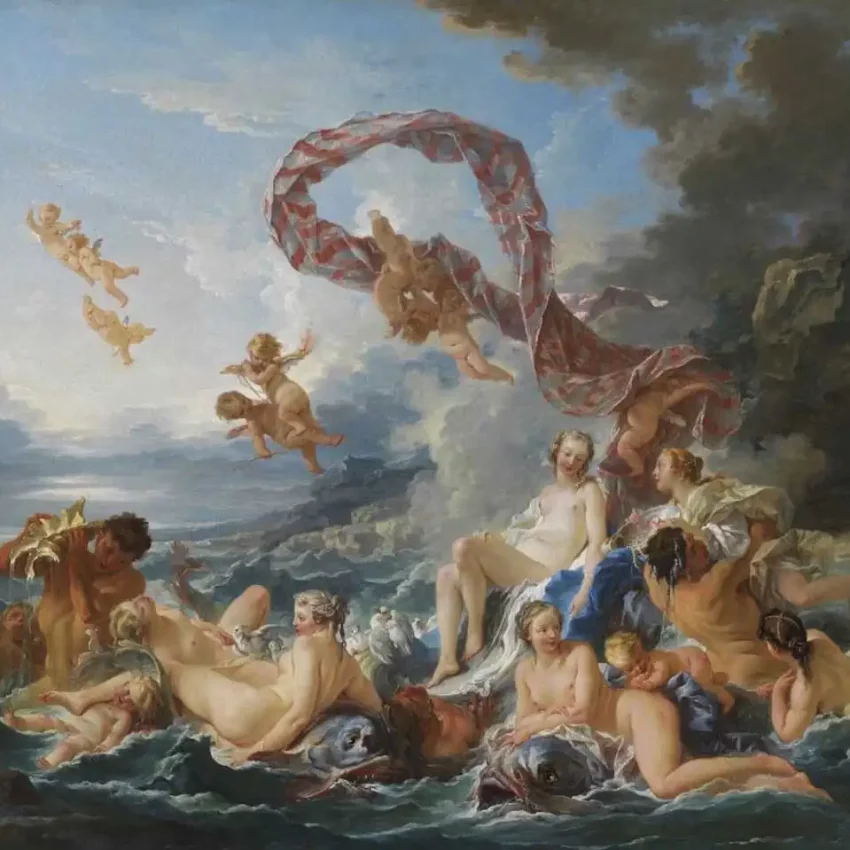Cubism Art Movement, History, Relevance, Artwork and The Tate
Cubism: An Artistic Revolution
Cubism, born in the early 20th century through the visionary minds of Picasso and Braque, is more than just an artistic style—it’s a revolution.
By breaking down traditional perspectives and presenting subjects from multiple viewpoints on a single canvas, Cubism challenged the very notion of representation in art.
The fragmented forms and geometric shapes used by Cubist artists aimed to push boundaries and provoke viewers into seeing the world in a new light.
Furthermore, Cubism blurred the lines between painting and sculpture by introducing collage techniques and emphasizing texture.
This bold approach not only revolutionized art but also paved the way for future movements by inspiring artists to explore unconventional methods of expression.
Ultimately, Cubism remains a testament to creativity unhinged, marking a significant turning point in the evolution of modern art.
History of Cubism
Cubism took root in the bustling art scene of Paris around 1910.
Spearheaded by Georges Braque and Pablo Picasso in 1907, the movement sought to deconstruct traditional notions of perspective and representation.
Inspired by African art, masks in particular, ancient Iberian sculptures and rejecting the realistic depiction of space and form, cubist artists aimed to capture the essence of an object from multiple viewpoints simultaneously.
This fragmentation of form laid the groundwork for the analytical and synthetic phases of cubism.
The movement emphasized geometric forms, fragmented shapes, and a deconstruction of objects into their fundamental elements.
By challenging conventional techniques and embracing abstraction, Cubist work, influenced by cubism, offered a new way of seeing and understanding the world.
Picasso famously remarked that every act painting is an act of war against tradition, highlighting the radical nature of this artistic movement.
Through the use of overlapping planes, shifting perspectives, and a dynamic interplay between light and shadow, Cubist artists aimed to capture the essence of their subjects in a more complex and multidimensional manner.
Ultimately, the origins of Cubism can be seen as a rejection of strict realism in favor of a more subjective interpretation of reality that paved the way for future developments in modern art.
1914
The outbreak of World War I in 1914 marked a tumultuous period for the cubist movement.
Many artists were forced to flee Paris, scattering across Europe and beyond.
Despite the upheaval, cubism continued to exert its influence, leaving an indelible mark on the trajectory of modern art.
Characteristics of Cubism Artwork
Cubist art is known for its unique characteristics that set it apart from other artistic movements.
One key aspect of Cubism is the fragmentation of objects into geometric shapes, creating a sense of multiple viewpoints within a single image.
This technique allows artists to depict subjects from different angles simultaneously, challenging traditional notions of perspective and representation.
Another defining characteristic of Cubist art is its emphasis on flat, two-dimensional surfaces rather than three-dimensional realism.
By breaking down forms into simplified shapes and planes, artists like Pablo Picasso and Georges Braque sought to explore the essence of their subjects rather than simply replicate their physical appearance.
This approach not only revolutionized the way we perceive art but also influenced other modern movements such as abstract art and surrealism.
Analytical Cubism
(Early cubism)
The early phase of cubism, known as analytical cubism, was characterized by a meticulous dissection of form.
Picasso and Braque pioneered this approach, producing works that fragmented objects into a myriad of geometric facets.
By breaking down subjects into their fundamental components, analytic cubism aimed to explore the essence of form and space
Synthetic Cubism
Following the analytical phase, cubism evolved into its synthetic stage, marked by a more intuitive and experimental approach.
Artists such as Juan Gris embraced collage and mixed media techniques, incorporating everyday objects and materials into their compositions.
Synthetic cubism blurred the boundaries between reality and representation, offering a multifaceted exploration of the visual world.
Crystal Cubism
Crystal Cubism, a later phase of the Cubist movement, is closely associated with Salon Cubism, which denotes the exhibition of Cubist artworks in traditional salon settings.
This association reflects the evolution of Cubism from its avant-garde origins to a more established and accepted style within the art world.
Artists like Pablo Picasso and Georges Braque, central figures in the Cubist movement, played significant roles in the development of Crystal Cubism.
Their experimentation with geometric forms and translucent effects gave rise to compositions reminiscent of crystal structures, hence the name.
Furthermore, Crystal Cubism is part of a larger artistic trend known as the Return to Order, or Interwar Classicism.
This trend emerged in the aftermath of World War I and was associated with artists in the School of Paris, including Picasso and Braque, who significantly influenced the cubism developed during this period.
The Return to Order movement sought to restore a sense of stability and traditional values in the wake of the chaos and upheaval of the war.
As such, Crystal Cubism represented a departure from the fragmented and abstract forms of earlier Cubist phases, embracing a more refined and ordered aesthetic.
Key Figures in the Cubist Movement
Pablo Picasso
Often hailed as the father of Cubism, revolutionized the art world with his groundbreaking works.
His collaborative efforts with Georges Braque, characterized by fragmented forms and abstract representations, paved the way for this avant-garde movement and were pivotal in the development of synthetic cubist techniques.
Picasso’s iconic painting “Les Demoiselles d’Avignon” is considered a cornerstone of Cubism, showcasing bold shapes and distorted figures that challenged traditional perspectives.
Georges Braque
Another influential figure in Cubism, brought a unique approach to the movement through his use of earthy tones and geometric shapes.
Braque’s quest to deconstruct reality led to innovative works like “Violin and Candlestick,” where he depicted objects from multiple viewpoints simultaneously – a hallmark of Cubist artistry.
This collaboration with Picasso marked a turning point in modern art history, forging a path for artists to explore new dimensions of creativity beyond conventional boundaries.
Juan Gris
Often regarded as the third major figure in the Cubist movement, contributed his distinctive style infused with analytical precision and vibrant colors.
Gris’s artwork transcended traditional still-life representations through intricate compositions and meticulous attention to detail.
His painting Portrait of Pablo Picasso exemplifies his ability to capture the essence of subjects using sharp angles and intricate patterns reflective of his unique interpretation within the Cubist canon.
Marcel Duchamp
Marcel Duchamp left a profound mark on cubism and beyond.
Born in 1887, Duchamp’s cubist leanings in Paris led to his groundbreaking “ready-made” concept, where everyday objects like “Fountain” challenged art norms.
Despite mixed ties with cubist leaders, Duchamp’s influence on the movement was clear, inspiring artists to expand artistic boundaries.
His legacy extends to conceptual art, reshaping artistic discourse and emphasizing ideas over aesthetics.
Duchamp’s impact endures, underscoring the lasting relevance of his pioneering approach to art.
Roger de La Fresnaye
Born in 1885, made significant contributions to cubism. Influenced by Cézanne and the Fauvists, he embraced cubism in the early 1910s, focusing on structure and geometry.
His innovative techniques, like overlapping planes, created dynamic compositions, marking a significant contribution to the cubist style.
Despite being overshadowed by others, La Fresnaye’s work influenced future artists, leaving a lasting impact on modern art.
Jean Metzinger
Metzinger’s artistic journey began with influences from the Impressionists and Post-Impressionists.
However, it was his encounter with the works of Picasso and Braque that ignited his interest in cubism.
Metzinger embraced cubism wholeheartedly, contributing to both the analytical and synthetic phases of the movement, substantiating his role as a prominent art historian within cubist circles.
His works often featured fragmented forms, multiple viewpoints, and geometric abstraction, challenging traditional notions of representation.
Metzinger’s contributions to cubism were marked by his innovative techniques and theories.
He developed the concept of “mobile perspective,” which allowed for the representation of multiple viewpoints within a single composition.
This approach added dynamism and depth to his works, distinguishing them within the cubist canon.
Albert Gleizes
Gleizes fully embraced cubism, becoming one of its foremost proponents.
His works often featured bold geometric forms, dynamic compositions, and a sense of rhythm that challenged traditional artistic conventions.
Gleizes was known for his innovative techniques, including the use of “multiple perspective” to depict multiple viewpoints within a single composition.
He also co-authored the influential treatise “Du Cubisme” with Jean Metzinger, which helped articulate and formalize the principles of cubist theory.
Paul Cézanne
Cézanne’s fascination with form led him to experiment with techniques such as “constructive stroke,” where he applied paint in distinct, angular brushstrokes to delineate shapes and volumes.
This approach marked a departure from the fluid, gestural style of Impressionism, foreshadowing the geometric abstraction of cubism.
Cézanne’s emphasis on the underlying structure of his subjects had a profound impact on the development of cubism.
Artists such as Picasso and Braque admired his ability to reduce forms to their essential geometric components, laying the foundation for cubist theories of abstraction and multiple perspectives.
Sonia Delaunay
Sonia Delaunay, born in Ukraine in 1885, was a pioneering force in the development of abstract art.
Embracing the principles of cubism, she introduced a unique sense of movement and rhythm into her compositions, often inspired by the dynamic energy of modern urban life.
Her bold use of color and geometric shapes, emblematic of the cubist painting approach, set her apart as a visionary artist, influencing subsequent generations of abstract painters.
Robert Delaunay
Robert Delaunay, born in Paris in 1885, was equally instrumental in the evolution of cubism.
He rejected the strict geometries of traditional cubist forms, instead opting for a more fluid and dynamic approach to representation.
His series of “Orphist” paintings, characterized by their vibrant colors and swirling compositions, marked a departure from conventional cubist techniques, paving the way for the emergence of abstract art.
Central to Robert and Sonia Delaunay artistic practices was the concept of simultaneity, whereby multiple perspectives and moments in time are represented simultaneously.
Through their use of vibrant colors and overlapping forms, they sought to capture the sensory experience of modern life, imbuing their artworks with a sense of dynamism and vitality.
Their innovative approach to color theory, influenced by the scientific principles of optics and perception, revolutionized the way artists approached color in their work.
Impact and Influence of Cubism
Ambroise Vollard
French art dealer Ambroise Vollard played a pivotal role in the avant-garde art scene of the early 20th century, serving as a crucial patron and promoter of innovative artists like Pablo Picasso and Georges Braque.
With a keen eye for emerging talent, Vollard recognized the revolutionary potential of Cubism and actively supported Picasso and Braque in their artistic endeavors.
Through his galleries and exhibitions, Vollard provided a platform for these groundbreaking artists to showcase their work to a wider audience, helping to facilitate their rise to prominence within the art world.
Vollard’s unwavering commitment to promoting avant-garde art not only contributed to the success of Picasso and Braque but also played a significant role in shaping the course of modern art history.
His support and patronage provided crucial validation for the Cubist movement, paving the way for its acceptance and recognition by the artistic establishment.
Vollard’s legacy as a pioneering art dealer and advocate for innovation endures, underscoring the importance of patronage in nurturing artistic talent and fostering artistic movements that challenge conventions and redefine artistic expression.
When considering the impact and influence of Cubism, we cannot overlook its revolutionary approach to representation.
This art movement shattered traditional norms by deconstructing forms and fragmenting reality into geometric shapes on canvas.
Through this unique perspective, artists such as Pablo Picasso and Georges Braque, pioneers of the cubism of Picasso and Braque, challenged viewers to see the world from multiple viewpoints simultaneously.
Furthermore, Cubism’s influence extended beyond the realm of visual arts, inspiring a sense of freedom and experimentation in other creative fields.
The principles of Cubism infiltrated literature, music, architecture, and fashion, leading to a wave of innovation across various disciplines.
This interdisciplinary impact showcased the enduring power of breaking boundaries and reimagining established conventions for artistic expression.
Evolution and Legacy of Cubism
Cubism, pioneered by artists Pablo Picasso and Georges Braque in the early 20th century, revolutionized the art world with its fragmented forms and multiple perspectives.
This avant-garde movement sought to depict objects from various viewpoints simultaneously, challenging traditional notions of representation.
As Cubism evolved, artists like Juan Gris further pushed the boundaries by incorporating collage techniques and exploring complex geometries.
The legacy of Cubism can be seen in subsequent artistic movements such as Surrealism and Abstract Expressionism, which also experimented with unconventional ways of representing reality.
Beyond its immediate impact on art, Cubism’s influence extends to contemporary design, architecture, and even fashion.
The movement’s emphasis on breaking down conventional boundaries continues to inspire creatives across various disciplines to think outside the box and explore new possibilities in visual expression.
Tate and the Cubist Art Movement
Artists in the Collection
The Tate Modern in London houses a significant collection of cubist artworks, providing visitors with a comprehensive overview of the movement’s evolution.
From Picasso’s groundbreaking Les Demoiselles d’Avignon to Gris’s vibrant still lifes, the Tate collection showcases the diverse range of artistic innovations that emerged from the cubist movement.
Criticisms and Controversies Surrounding Cubism
One of the major criticisms surrounding Cubism is its perceived rejection of traditional artistic techniques and realistic representation.
Critics argue that the fragmented nature of Cubist artworks can make them difficult for viewers to understand or appreciate, leading to a sense of alienation among some audiences.
Additionally, some art enthusiasts have pointed out that the movement’s emphasis on geometry and abstraction, typical of the cubist style, can be seen as too radical and disconnected from the world as we perceive it.
Controversies have also arisen regarding the intentions of Cubist artists in relation to their portrayal of human figures and subjects.
Some critics speculate about whether Cubism sought to dehumanize its subjects by breaking them down into geometric shapes, challenging conventional notions of beauty and form in art.
This approach has led to debates over the true meaning behind these abstract compositions and sparked discussions about the boundaries between representation and abstraction in artistic expression.
Louis Vauxcelles
Art critic Louis Vauxcelles is perhaps best known for coining the term “cubism.” In 1908, while reviewing the Salon d’Automne, he encountered the works of Picasso, Braque, and other cubist artists.
Struck by the geometric forms and fragmented perspectives evident in their paintings, Vauxcelles famously described the works as being composed of “cubes.”
This term, initially coined as a form of derision, would later become synonymous with one of the most significant movements in modern art.
As a critic, Vauxcelles played a crucial role in shaping public perception of cubism.
His reviews, often published in prominent art journals and newspapers, helped to introduce cubism to a wider audience while also sparking debates and controversies within the art world.
While some praised cubism for its innovative approach to representation, others criticized it as being overly abstract and difficult to comprehend.
Vauxcelles’ nuanced critiques navigated these complexities, providing valuable insight into the artistic merits and significance of the cubist movement, a task that endears him to art historians.
Conclusion: The Lasting Impact of Cubism
In conclusion, Cubism emerged as a groundbreaking avant-garde movement in the early 20th century, forever altering the course of art history.
Developed by two artists Pablo Picasso and Georges Braque, Cubism challenged traditional artistic conventions, introducing fragmented forms and multiple perspectives.
French art critic Louis Vauxcelles famously coined the term “cubism” and played a significant role in shaping public perception of the movement.
The later phase of Cubism, known as Synthetic Cubism, saw artists like Picasso and Braque experimenting with collage and mixed media techniques, further expanding the movement’s boundaries.
Cubism exerted a profound influence on high art and inspired subsequent art movements like Art Deco and Surrealism, reshaping the history of art through its innovative approaches.
Today, Cubism remains synonymous with innovation and dynamism, with works by Picasso and Braque prominently displayed in prestigious art institutions such as the Metropolitan Museum of Art. Its legacy endures as a testament to the power of artistic experimentation and the enduring influence of the avant-garde art movement on 20th-century art history
Braque and Picasso, continued to push the boundaries of artistic expression with their landscape paintings and exploration of Iberian art influences.
French art dealer Ambroise Vollard played a pivotal role in promoting the work of Picasso and Braque, facilitating their rise to prominence within the art world.
Cubism’s association with high art and its dynamic movement became evident through exhibitions in prestigious art galleries, including the Gallery of Art in Washington, D.C., and the Museum of Modern Art.
The fusion of Cubism and Futurism inspired a number of artists and designers, influencing subsequent art movements like Art Deco and the Surrealist movement.
Overall, Cubism’s impact on 20th-century art history is undeniable, shaping the trajectory of modern art and leaving a lasting legacy that continues to inspire artists and art enthusiasts alike.
As we reflect on the lasting impact of Cubism, it becomes clear that this revolutionary art movement has left an indelible mark on the world of visual arts.
By challenging traditional artistic conventions and pushing boundaries, Cubism paved the way for future innovative movements and inspired countless artists to think beyond the constraints of realism.
Its emphasis on breaking down forms into geometric shapes and fracturing images introduced a new way of perceiving and representing reality, a hallmark of the profound influence exerted by cubism on still life and other genres.
Furthermore, the influence of Cubism extends far beyond the realm of art itself.
Its focus on multiple perspectives, fragmentation, and abstraction can be seen resonating in various other disciplines such as literature, design, and even psychology.
The legacy of Cubism is not confined to a specific time period or style; rather, it continues to inspire creativity and experimentation across different fields as a testament to its enduring relevance in contemporary culture.





